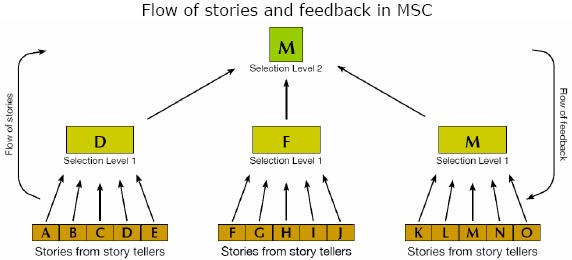Difference between revisions of "Most Significant Change (MSC)"
From Learning and training wiki
| Line 1: | Line 1: | ||
| − | {{Term|Most Significant Change (MSC)<ref>Davies Rick, and Dart Jess, ''The Most Significant Change (MSC) Technique: A Guide to Its Use'', Version 1.00, April 2005 </ref>|The most significant change (MSC) technique is a form of participatory monitoring and evaluation. | + | {{Term|Most Significant Change (MSC)<ref>Davies Rick, and Dart Jess, ''The Most Significant Change (MSC) Technique: A Guide to Its Use'', Version 1.00, April 2005 </ref>|The most significant change (MSC) technique is a form of participatory monitoring and evaluation. It is participatory in the sense that many project stakeholders are involved in deciding the sorts of change to be recorded and in analyzing the data collected. It is a form of monitoring because it occurs throughout the program cycle, providing information to help people manage it. It contributes to evaluation because it provides data on [[Impact|impact]] and [[Outcomes|outcomes]] that can be used to help assess a programme’s performance as whole. |
| − | + | ||
| − | + | ||
| − | + | ||
| − | |||
| − | MSC | + | The MSC process involves the collection of significant change (SC) stories emanating from a particular project and the systematic selection of the most significant of these stories by panels of designated stakeholders or staff. The process is developed around positive questioning such as ''Looking back over the (concerned period), what do you think was the most significant change in [particular domain of change]?'' or ''From among all these significant changes, what do you think was the most significant change of all?'' |
| − | |||
| − | The | + | The MSC can potentially influence organizational learning through its horizontal and vertical processes. The horizontal dimension is between a group of participants engaged in discussing and selecting the most significant of a set of stories while the vertical dialogue involves exchanges of views between groups of participants at different levels. The vertical dimension is particularly important if the MSC process is to assist organizational learning throughout the organization. It will depend on good documentation and communication of the results of one group’s discussion to the other. |
| − | + | ||
| − | + | ||
}} | }} | ||
Revision as of 09:47, 11 December 2009
| The most significant change (MSC) technique is a form of participatory monitoring and evaluation. It is participatory in the sense that many project stakeholders are involved in deciding the sorts of change to be recorded and in analyzing the data collected. It is a form of monitoring because it occurs throughout the program cycle, providing information to help people manage it. It contributes to evaluation because it provides data on impact and outcomes that can be used to help assess a programme’s performance as whole.
|
|
For a successful MSC implementation, it is necessary to create and facilitate the following contexts:
Step By Step[2]Step 1: Starting and raising interest
Using domains of change helps organizations to group a large number of SC stories into more manageable lots, which can each be analyzed in turn. The “any other type of change” domain is a useful open category that allows participants to report significant changes that don’t fit into the named domains. Between three and five domains is a manageable number. The limiting factor is how much time participants are willing to spend in discussing each domain. Domain can be identified before SC stories are selected or afterwards by sorting SC stories into meaningful groups. This depends on the extent to which the organization wants to be open to new experiences rather than continuing to be guided by past experiences.
The frequency of collection of SC stories has varied from fortnightly to yearly. Each organization has to make its own decision about the most appropriate reporting period, balancing the costs and benefits involved, and taking into account the reporting gaps that any existing monitoring and evaluation systems may be ignoring. Our experience suggests that organizations tend to start MSC with more regular reporting and decrease the frequency as the process continues.
How to capture SC stories:
Most MSC stories are a page or less in length, with some being up to two pages. Shorter MSC stories are quicker and easier to read, but they should not be so short that vital information is left out.
When a storyteller tells a story, the person collecting the story needs to explain how the story is to be used and to check that the storyteller is happy for the story to be used. The storyteller should also be asked whether they wish their name to accompany the story. Even when consent has been given, it is good practice to check with storyteller before placing any stories in external media such as newspapers.
For each domain the group will select a story that they believe represents the most significant change of all. The selection process invariably begins with reading some or all of the stories wither out loud or individually. The key ingredients to story selection are:
The group must decide whether the criteria for selecting stories will be identified before or after reading stories. If MSC is being used to aid organizational learning , the selection criteria should not be decided in advance but should emerge through discussion of the reported changes. There are several ways of reaching a decision about which stories to select:
Building capability for effective MSC[3]Job Aid |
